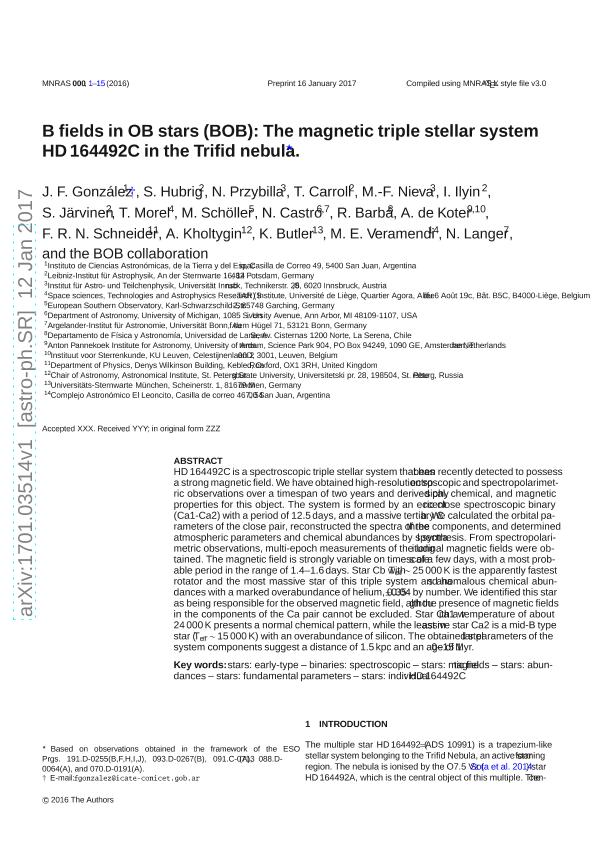Mostrar el registro sencillo del ítem
dc.contributor.author
Gonzalez, Jorge Federico

dc.contributor.author
Hubrig, S.
dc.contributor.author
Przybilla, Norbert

dc.contributor.author
Carroll, T. A.
dc.contributor.author
Nieva, Maria Fernanda

dc.contributor.author
Ilyin, I.

dc.contributor.author
Järvinen, S.
dc.contributor.author
Morel, T.
dc.contributor.author
Schöller, M.
dc.contributor.author
Castro, N.
dc.contributor.author
Barba, Rodolfo Hector

dc.contributor.author
de Koter, A.
dc.contributor.author
Schneider, F. R. N.
dc.contributor.author
Kholtygin, A. F.
dc.contributor.author
Butler, K.
dc.contributor.author
Veramendi Pont, María Eugenia

dc.contributor.author
Langer, N.
dc.contributor.author
The BOB Collaboration

dc.date.available
2018-10-29T16:51:48Z
dc.date.issued
2017-01
dc.identifier.citation
Gonzalez, Jorge Federico; Hubrig, S.; Przybilla, Norbert; Carroll, T. A.; Nieva, Maria Fernanda; et al.; B fields in OB stars (BOB): The magnetic triple stellar system HD 164492C in the Trifid nebula; Wiley Blackwell Publishing, Inc; Monthly Notices of the Royal Astronomical Society; 467; 1; 1-2017; 437-450
dc.identifier.issn
0035-8711
dc.identifier.uri
http://hdl.handle.net/11336/63184
dc.description.abstract
HD 164492C is a spectroscopic triple stellar system that has beenrecently detected to possess a strong magnetic field. We have obtainedhigh-resolution spectroscopic and spectropolarimetric observations overa timespan of two years and derived physical, chemical, and magneticproperties for this object. The system is formed by an eccentric closespectroscopic binary (Ca1-Ca2) with a period of 12.5 days, and a massivetertiary Cb. We calculated the orbital parameters of the close pair,reconstructed the spectra of the three components, and determinedatmospheric parameters and chemical abundances by spectral synthesis.From spectropolarimetric observations, multi-epoch measurements of thelongitudinal magnetic fields were obtained. The magnetic field isstrongly variable on timescales of a few days, with a most probableperiod in the range of 1.4-1.6 days. Star Cb with T<sub>eff</sub>? 25 000 K is the apparently fastest rotator and the most massivestar of this triple system and has anomalous chemical abundances with amarked overabundance of helium, 0.35±0.04 by number. Weidentified this star as being responsible for the observed magneticfield, although the presence of magnetic fields in the components of theCa pair cannot be excluded. Star Ca1 with a temperature of about 24 000K presents a normal chemical pattern, while the least massive star Ca2is a mid-B type star (T<sub>eff</sub> ? 15 000 K) with anoverabundance of silicon. The obtained stellar parameters of the systemcomponents suggest a distance of 1.5 kpc and an age of 10-15 Myr.
dc.format
application/pdf
dc.language.iso
eng
dc.publisher
Wiley Blackwell Publishing, Inc

dc.rights
info:eu-repo/semantics/openAccess
dc.rights.uri
https://creativecommons.org/licenses/by-nc-sa/2.5/ar/
dc.subject
Stars: Early Type
dc.subject
Binaries: Spectroscopic
dc.subject
Stars: Magnetic Fields
dc.subject
Stars: Abundances
dc.subject
Stars: Fundamental Parameters
dc.subject
Stars: Individual: Hd 164492c
dc.subject.classification
Astronomía

dc.subject.classification
Ciencias Físicas

dc.subject.classification
CIENCIAS NATURALES Y EXACTAS

dc.title
B fields in OB stars (BOB): The magnetic triple stellar system HD 164492C in the Trifid nebula
dc.type
info:eu-repo/semantics/article
dc.type
info:ar-repo/semantics/artículo
dc.type
info:eu-repo/semantics/publishedVersion
dc.date.updated
2018-10-22T17:26:09Z
dc.journal.volume
467
dc.journal.number
1
dc.journal.pagination
437-450
dc.journal.pais
Reino Unido

dc.journal.ciudad
Londres
dc.description.fil
Fil: Gonzalez, Jorge Federico. Consejo Nacional de Investigaciones Científicas y Técnicas. Centro Científico Tecnológico Conicet - San Juan. Instituto de Ciencias Astronómicas, de la Tierra y del Espacio. Universidad Nacional de San Juan. Instituto de Ciencias Astronómicas, de la Tierra y del Espacio; Argentina
dc.description.fil
Fil: Hubrig, S.. Leibniz Institut für Astrophysik; Alemania
dc.description.fil
Fil: Przybilla, Norbert. Universidad de Innsbruck; Austria
dc.description.fil
Fil: Carroll, T. A.. Leibniz Institut für Astrophysik; Alemania
dc.description.fil
Fil: Nieva, Maria Fernanda. Universidad de Innsbruck; Austria
dc.description.fil
Fil: Ilyin, I.. Leibniz Institut für Astrophysik; Alemania
dc.description.fil
Fil: Järvinen, S.. Leibniz Institut für Astrophysik; Alemania
dc.description.fil
Fil: Morel, T.. Université de Liège; Bélgica
dc.description.fil
Fil: Schöller, M.. European Southern Observatory; Alemania
dc.description.fil
Fil: Castro, N.. University of Michigan; Estados Unidos. Universitat Bonn; Alemania
dc.description.fil
Fil: Barba, Rodolfo Hector. Universidad de La Serena; Chile. Consejo Nacional de Investigaciones Científicas y Técnicas; Argentina
dc.description.fil
Fil: de Koter, A.. University of Amsterdam; Países Bajos. Katholikie Universiteit Leuven; Bélgica
dc.description.fil
Fil: Schneider, F. R. N.. Denys Wilkinson Building; Reino Unido
dc.description.fil
Fil: Kholtygin, A. F.. St. Petersburg State University; Rusia
dc.description.fil
Fil: Butler, K.. Universitäts-Sternwarte München; Alemania
dc.description.fil
Fil: Veramendi Pont, María Eugenia. Consejo Nacional de Investigaciones Científicas y Técnicas. Centro Científico Tecnológico Conicet - San Juan. Complejo Astronómico ; Argentina
dc.description.fil
Fil: Langer, N.. Universitat Bonn; Alemania
dc.description.fil
Fil: The BOB Collaboration. No especifica;
dc.journal.title
Monthly Notices of the Royal Astronomical Society

dc.relation.alternativeid
info:eu-repo/semantics/altIdentifier/doi/https://dx.doi.org/10.1093/mnras/stx105
dc.relation.alternativeid
info:eu-repo/semantics/altIdentifier/url/https://academic.oup.com/mnras/article-abstract/467/1/437/2907764
dc.relation.alternativeid
info:eu-repo/semantics/altIdentifier/url/https://arxiv.org/abs/1701.03514
Archivos asociados
